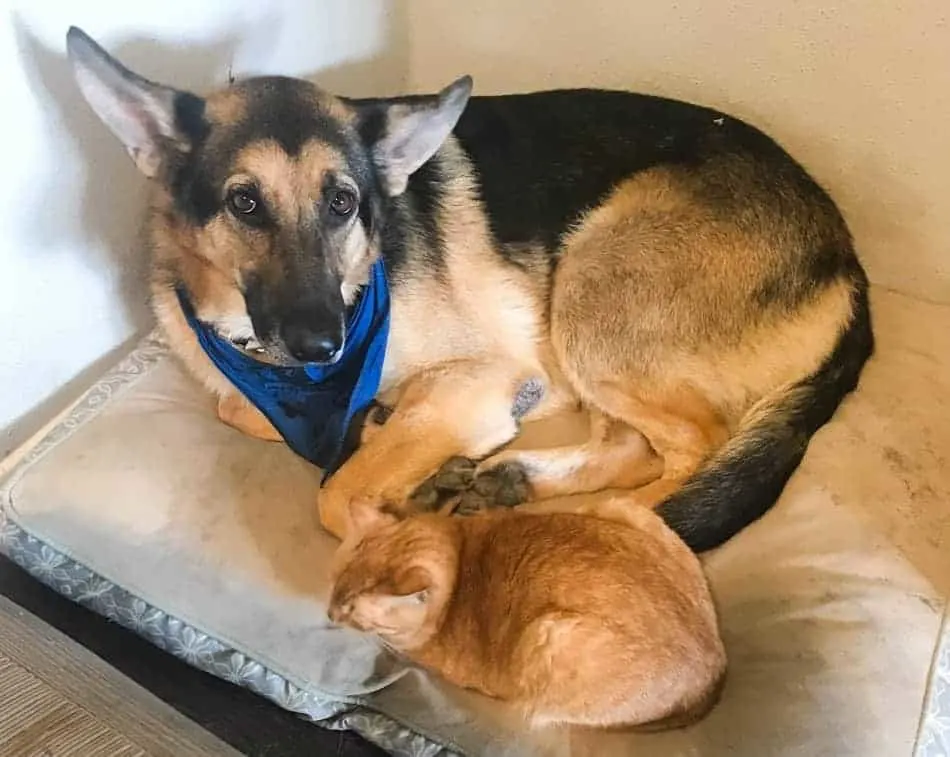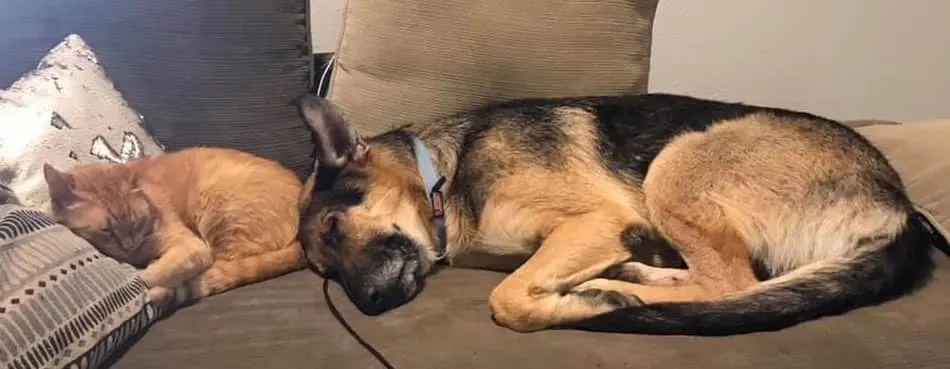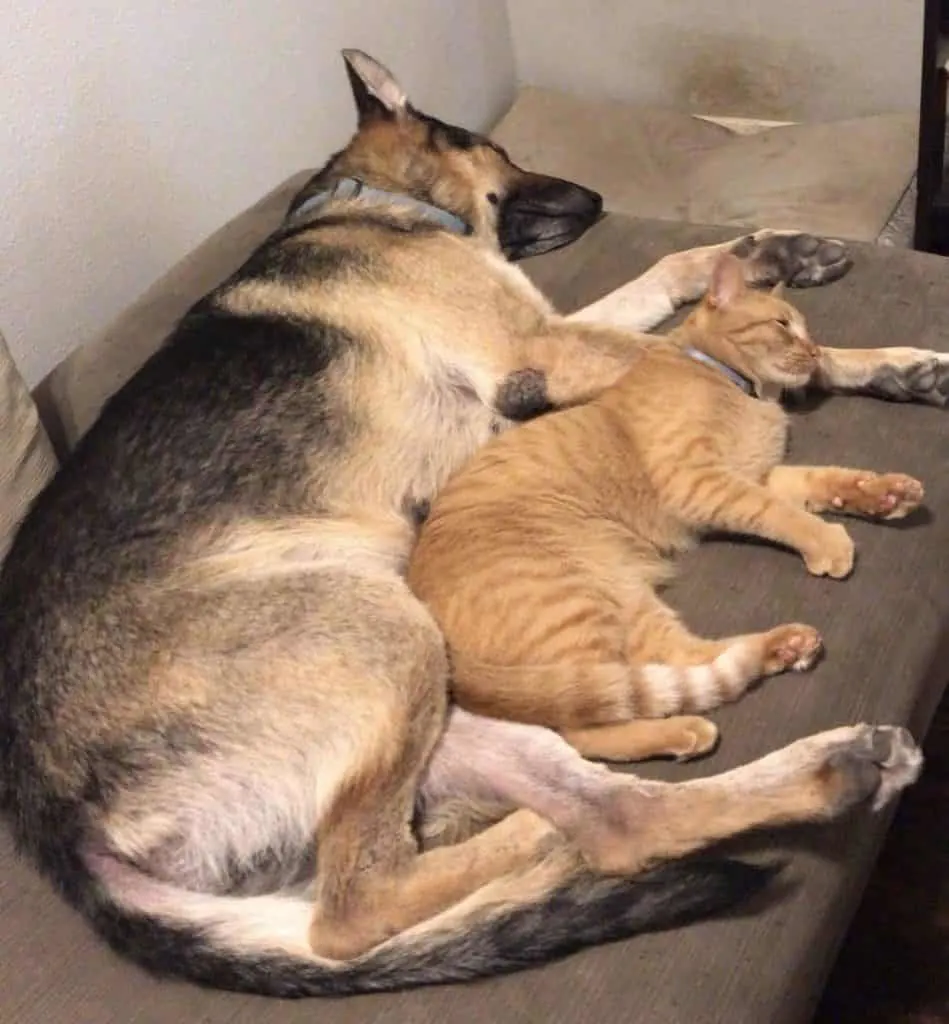
One of my German Shepherds naturally loved cats.
And most cats did not seem to take issue with him either.
However, this is not always the case. So in this post, I’ll explain in some detail the answer to the following question:
Can German Shepherds get along with cats?
While some German Shepherds naturally get along with cats, others may shy away from or even be aggressive towards them.
However, with the proper training and introduction, German Shepherds can and often do get along with cats very well.
Often it takes a bit of work before everything is fun and games between a GSD and a cat.
There are few considerations to be taken into account, as well as some things that you can do to make this happen.
Click Here to Jump to a Section
Personality Of The GSD
The GSD is a herding dog with prey drive. Its natural instinct is to herd, chase, and protect.
They may not mean any harm, but this can be quite scary and alarming to the animal being chased – even if the GSD is just having fun.
This does not mean that a GSD will chase every cat every time, but it is important to be aware that this is an inherent characteristic of the German Shepherd.
Personality Of The Cat
Cats tend to be very cautious and reserved, especially in new situations and in new environments.
Like people, some cats are bold and some are timid.
This variable spans a wide spectrum, but in general cats will approach a new situation with more weariness than a dog.
Keep this in mind when thinking of introducing your GSD to one.
Age Of The Dog And Cat
As a general rule, a puppy will have an easier time being introduced to a cat than an adult dog and stands a better chance of getting along with it.
However, this is by no means always the case, and if done properly, most well-socialized GSDs will have no issues with a cat being introduced into its life.
Similarly, if the cat in question is a kitten at the time of introduction to a GSD puppy, it stand much less chance of being frightened or anxious.
Prior Experience (Socialization)
Whether or not your GSD will get along well with a cat has a lot to do with how socialized it is.
This basically means that the more your GSD has been exposed to other animals in the past, and the more positive interactions it has had with them, the more likely it will be that it gets along well with a cat.
If your GSD has had the misfortune of having prior negative interactions with other animals, then it may require a bit more understanding on your part on how to proceed.
Negative prior experiences may cause your GSD to be nervous or scared around other animals, and they may be aggressive towards them as a matter of self-protection.
Should this be the case, it’s a good idea to speak with your veterinarian or a dog trainer on how best to approach addressing this issue.
Regardless of whether or not you may think that your GSD will get along well with your cat, it is important for the physical and emotional safety of both animals that you make the introduction in a calculated and measured way.
Controlled introduction
You may be tempted to just let your GSD and cat sort out their relationship for themselves.
And this may actually work. As mentioned, sometimes a GSD and cat relationship will start out like old friends and stay that way.
But this is not a chance that you should take. A controlled introduction is a more measured approach.
Think of it this way – would you rather take part in the beginning of a positive relationship, or would you rather try and mend a damaged one?
Making sure that you do this properly is important to both your GSD and your cat’s long-term mental and physical well-being.
Preparing Your Cat For The Introduction
If you are bringing a new cat into the home, make sure that the cat has space to settle in. This may be its own room, like a spare bedroom.
And make sure that the room has all of the resources that the cat needs – like a litter box, food, water, and toys.
This lets the cat know that there is a place to retreat and thereby keeps its stress levels to a minimum.
Basic training for your GSD
Before even thinking about introducing your GSD to a cat, you need to make sure that it is adequately trained.
Your GSD should be able to sit and stay without any hesitation, every time. Most importantly, your GSD needs to be calm for the introduction phase.
Your GSD may need to be desensitized to the cat and counter-conditioned. What this means is that the cat can no longer be something that gets the dog over-excited.
The Introduction

There are no specific rules to this in terms of the amount of time that you need to spend on any of the steps listed below.
Instead, you must use your best judgment based on your knowledge of the particular dog and cat being introduced to one another.
1. Scent Swapping
This is actually the most important part of the introduction process.
To begin this part of the process, gather one clean cloth for your GSD, and one for your cat. “Clean” meaning that there is no prior scent from another animal on the cloth.
From there the cloth needs to be rubbed on the scent glands of the animals.
On a cat, the scent glands are located around their cheeks and chin, and on their foreheads (this is why cats are always rubbing these areas against you – they are not being cute, they are marking you with their scent!)
On a dog, the scent glands are located in their armpits and on their sides.
You then need to place each cloth in the other animal’s environment. You don’t want to force either animal to smell the cloth, but instead, you should give them the option to approach the cloth and smell it if they choose to.
You then need to observe the behavior of your GSD and your cat to give you a gauge on how well the introduction is going.
Pay attention to whether your GSD gets aggressive or curious, and pay attention to whether your cat begins to act nervous or apprehensive.
You will also need to keep the scent constant.
To do this, simply rub the towel over the dog and cat’s scent glands once per day. This will ensure that the scent of the other animal is fresh and constant.
2. Face Time Through Glass
The next step in the progression of introducing your GSD to your cat is to give them some face time together.
You can do this by keeping your cat inside of your house and your dog outside – using a patio door as the barrier.
This gives both your cat and your dog a choice of whether or not to approach each other.
This is very important, as you do not want to force an interaction because that may cause uneasiness and apprehension in one or both of them.
If possible, have both people be either household members or people with who the animals recognize and are very familiar. Do this repeatedly for a few days, about 5 or so minutes each time.
3. Face Time Within The House
After you have done this, move on to doing the same thing inside your house – and with less of a barrier between the cat and the dog.
A good way to do this is by using a pet gate, or a baby gate, and have the animals stand on either side of it.
This allows them to see each other and even have light contact, but it will avert the possibility of aggressive contact from either animal.
Do this frequently, and give the animals treats during the process. You are building up to a barrier-free introduction.
4. Physical Face To Face Meeting
Now it’s time for more facetime, but this time with no barrier between your dog and cat. Except now make sure that your GSD is leashed.
This gives your cat the freedom to leave the situation if it feels uncomfortable.
As you continue to do this, you can allow your dog more leash little by little. This will allow it more freedom to interact with the cat while still maintaining control over it.
When your GSD does positively interact with your cat, reward it. Each time this happens, give your dog a treat and gentle verbal praise.
5. The Final Meeting – Unleashed
The next step is to let your dog off the leash. ONLY do this if you are confident that your GSD will remain calm and doesn’t pose a threat to the cat.
It’s also important here that you get an accurate gauge on how your cat is feeling.
If you have any doubt that your cat is ready for this introduction, do not let your dog off of its leash.
Remember that cats are not as animated in their expressions as dogs are. Their emotional cues are more subtle.
To check that your cat is feeling calm and relaxed, make sure that its ears are facing forward and that its pupils are not too small or too enlarged.
Other Important Considerations

Don’t Force It
Keeping the respective dog and cat’s personalities in mind is very important if you want your GSD and cat to get along.
Some cats fit right into the common saying “curious as a cat.”
They will have a natural curiosity towards your dog and be excited to investigate their new companion without any encouragement.
Other cats are by nature shy and reserved.
They may even fear the introduction of any new animal into their environment.
Or they may fear being placed into a new environment altogether.
It’s important to allow your cat to naturally express itself in the way that it wants to.
If it wants to leave the room or go hide somewhere, just allow this to happen.
Never Punish Either Animal
It’s not uncommon for a GSD to growl or even lunge at a cat when it is first introduced.
Understand that this is just part of your GSD’s instinct.
Under no circumstances should you yell “BAD DOG!” or punish your dog in any way.
It is only acting according to its natural instinct.
Think of when you meet someone new – sometimes they just rub you the wrong way, so to speak.
But how many times have these people ended up as good friends in the long run?
Potential Problems
If the introduction doesn’t go well at first, be patient, and stay positive.
Sometimes positive interaction between a cat and a GSD will not happen right away.
If you’re lucky, the introduction may need little or no assistance on your part.
But keep in mind that the time it may take your cat and GSD to become familiar with one another.
As mentioned, this may just happen immediately.
On the other hand, this could also take months. Dogs and cats can be shy and stubborn just like people.
Your animals can sense your energy, and if you stay patient and positive, your animals will emulate this.
Even if your GSD and cat are well-socialized animals, and you have taken the proper steps to introduce them to one another – problems can still occur.
Preexisting behavioral problems like aggression, fear, or anxiety may be the cause, or perhaps it is another factor in your home that you are simply not aware of.
But before you decide to give up, there are a few other options that you may wish to explore.
- Take your GSD or your cat to an animal behaviorist.
- Take your GSD or your cat to a dog or cat trainer (respectively!)
If you do choose to take your dog or cat to a trainer, make sure that you choose a professional who uses positive and not punitive methods. - This can cause stress in your dog or cat in the long-term, even if it works initially. It can also exacerbate existing behavioral problems down the line.
And remember, be patient.
The steps you take now towards introducing your GSD and your cat will pay off in the long run. Most importantly, don’t give up – be the example for your animals, their happiness is your gift!
